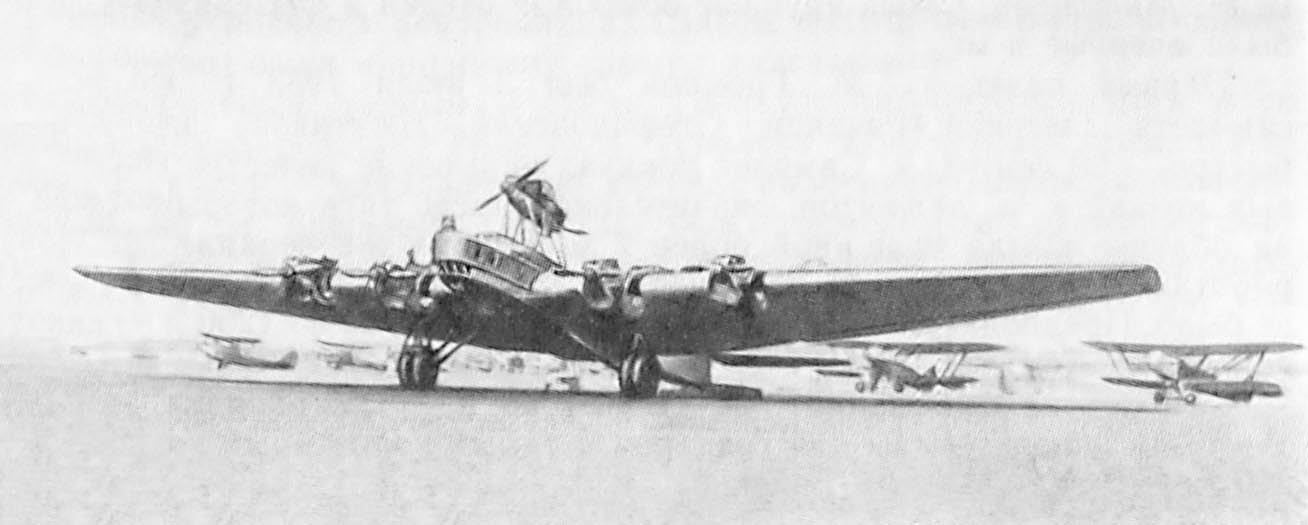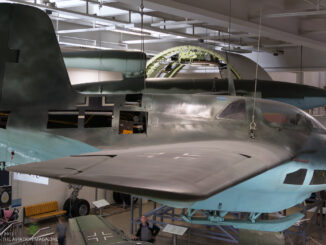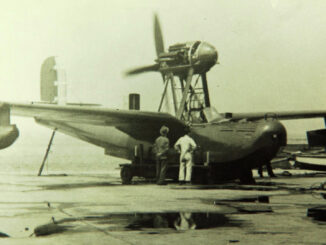
Handley Page Halifax entered service with No. 35 Squadron at RAF Linton-on-Ouse.
The Handley Page Halifax was a heavy bomber with a double vertical stabilizer, developed in response to Specification P.13/36 issued by the British Air Ministry in 1936. This document concerned a need of creating a medium-sized, high-performance bomber, that had to constitute a kind of back up for another RAF bomber of that class, Avro 679 (Avro Manchester).
The first two prototypes of the new Handley Page bomber – initially designated as HP.56, were built yet in 1937. Originally, the aircraft was powered by two Rolls-Royce Vulture engines, the same as those used in the Avro Manchester. However, after a series of trials and tests of the new bomber, the results were unsatisfactory, just because of the mentioned engines which turned out to be underdeveloped and underperformed. The problem was that engine was originally designed to generate about 1,750 hp, but, due to continuing problems with its design, its power was actually decreased to around 1,450 – 1,550 hp by limiting its maximum RPM. However, it finally made this engine insufficient for both Avro and Handley Page bombers.
Therefore the project team, in agreement with the Air Ministry, decided to change the type of the engines and also increased their number. The two Vulture engines were replaced by four Merlin X engines of the same manufacturer. The Rolls-Royce Merlins, fitted with a two-speed supercharger, generated 1,010 – 1,145 hp depending on the altitude. The change of the engines allowed also a slight increase of dimensions of the airframe, although its overall design remained quite the same.
Works on another two prototypes, this time designated as HP.57, were launched in March 1938. And the first of them – L7244, piloted by chief test pilot Jim Cordes and E. A. ‘Ginger’ Wright – performed its maiden flight on 25th October 1939. The initial tests were so promising that the RAF already ordered 100 examples of the new bomber, now officially named Handley Page Halifax.
The second prototype, L7245, took-off for its maiden flight on 17th August 1940, this time with full armament and operational equipment. And only two months later, on 11th October, it was followed by the first serial-manufactured Halifax Mk.I.
That early variant of Handley Page bomber had a 6,7 m long bomb bay, six additional smaller bomb cells in the wings and was able to carry up to 5,900 kg of bomb load. Its defensive armament included two .303 Browning machine guns in the nose turret and another four Brownings in the tail turret. Some of early manufactured Halifax aircraft have also had two additional Vickers K machine guns installed in waist positions.
The Handley Page Halifax entered operational service on 13th November 1940, being assigned to No. 35 Squadron RAF. However, the new bomber had to wait until March 1941 for its first combat mission – it was performed on the night of 10 / 11 March 1941 when six Halifax aeroplanes raided the Kriegsmarine docks in Le Havre. The RAF kept the existence of new bombers confidential until July 1941 and confirmed it at the opportunity of daylight raid on German battleship Scharnhost, then located in La Pallice.
During the next years, Halifax bombers performed several night-time raids against targets in Germany and occupied Europe. After the D-Day, they were also used for a day-time operations, for example against the V-1 launch sites. In 1944, twenty-six Bomber Command squadrons were equipped with Handley Page Halifax aircraft. They were also the only British four-engine bombers being used in the Middle East, operating from Palestine.
The Handley Page Halifax was also being widely used for special operations, performing lonely, long-haul night missions over the Germany-occupied territory to provide support and supplies for various resistance groups in Europe. They were also used for maritime patrols and coastal defence (operating from the UK and Gibraltar), towing gliders and carrying airborne troops.
The last combat flight of Handley Page Halifax during the World War II took place on 3rd May 1945, but they remained in active service until 1952, mostly in patrol and transport variants. In total, there were 6,176 Halifax bombers manufactured, in 14 different variants. They performed 75,532 combat operations during the war and dropped 227,610 tonnes of bombs, that gave them the second place in the RAF – just behind Avro Lancaster, the other four-engine bomber in the shadow of which Halifax, in some measure, remains until today.
Apart from the RAF, the Halifax bombers were also operated by the Royal Canadian Air Force, the Royal Australian Air Force, the Royal New Zealand Air Force, the Polish Air Force and the Free French squadrons.
Photo: Halifax Mark II Series 1, R9441 ‘TL-S’, of No. 35 Squadron RAF, on the ground at Linton-on-Ouse, Yorkshire. R9441 later served with No. 102 Squadron RAF, and No. 1652 Heavy Conversion Unit with whom it crashed on taking off from Marston Moor on 4 April 1943. © IWM ATP 10774B. Catalogue number: ATP 10774B. Part of: ROYAL AIR FORCE AIRCRAFT 1941-1959: ATP COLLECTION (GSA 325)



